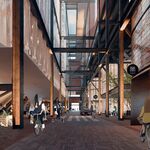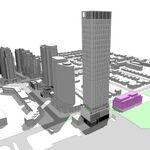My point is not a strawman, it is in fact central to my argument and to miss this is to misunderstand my argument: I'm not disputing whether Montreal gets more snow or whether bike lanes in general are desirable... I would exclaim a hearty 'yes' to both of those things!... my point is whether bike lanes as a funding choice makes reasonable sense in a declining economy when there are far more pressing funding demands out there, and far better ways to resolve traffic gridlock and address travel/commuting times for Torontonians. Without muddying the waters further this is the heart of my argument. You disagree?
You refuted a position (Montrealers in general are cycling to work daily in winter) that superficially resembles several forumers' point of view, but one that nobody has actually taken. That's the very definition of a strawman argument.
The point of the Jarvis project isn't to resolve traffic gridlock or address travel/commuting times. So whether or not I agree with that point is irrelevant...I'm not the one muddying the waters here.
Also, as for your statistic of 13 to 17% you are lumping walking and cycling in together, and the bigger portion is likely skewed to walking which means that the number of those cycling daily is extremely small.
Stats Canada lumps them together.
You are speculating. All we can do is criticize how the funds *are* going to be spent and adovacte for how we think they should be spent. You may trivialize the issue as simply 'painting lines' but sources show some $7 million dollars being earmarked for this.
I'm not speculating at all. Look at the last federal budget. It contains new infrastructure spending that wouldn't exist if we weren't in recession. There's also a fund specifically for "green" projects, and the province has indicated that it's going to match all that funding. I'm not saying that this particular project is being paid for by federal or provincial money, but that's not the issue here - your point ("whether bike lanes as a funding choice makes reasonable sense in a declining economy") is a general one, not specific to this project. And it doesn't change the fact that there's more money to spend on infrastructure in a declining economy, not less.
By the way, the PIC display boards don't even mention bike lanes - the preferred option mentions "opportunity for bicycle friendly curb lanes". There won't be bike lanes....unless of course I'm missing something.
I agree that the pending Depression-era spending sprees on infrastructure bode well for mass transit in the city and GTA but if you read through the DRL thread(s) here you will see that nothing certain has been decided and people in Toronto are still essentially begging for scraps in terms of what is truly needed to bring Toronto infrastructure up to date, nevermind expand it to meet the needs of growth and development. My criticism of funding for bike lanes is not an attack against bike lanes it is an attack against funding prioritization. Arguing for the health or lifestyle benefits of biking is the actual strawman here... one could even argue that true benefits to health quality in the city will only really happen by taking more cars off the road which will be better achieved through promoting and expanding mass transit, not cycling.
Well I for one have said nothing about the health benefits of cycling, so the only one using health as a strawman is you. All this debate about cycling is missing the point - this project is intended to make Jarvis more pedestrian friendly and improve the streetscape while still moving traffic. No bike lanes (again, unless I'm missing something).
The real increase to Torontonians this year is about 10% when you look beyond the increase to property taxes. In addition, inflation rates in Ontario and Toronto have been dropping over the past year. These increases are a cash grab to fund budgetary priorities. I'm simply questioning the prioritization.
You were looking for proof of some of my numbers earlier, so I'd like to see some proof of that 10% figure. Even if it's accurate, it doesn't change the fact that most of the property tax increase is due to inflation and reducing commercial and industrial taxes. And that's all I was trying to say.





